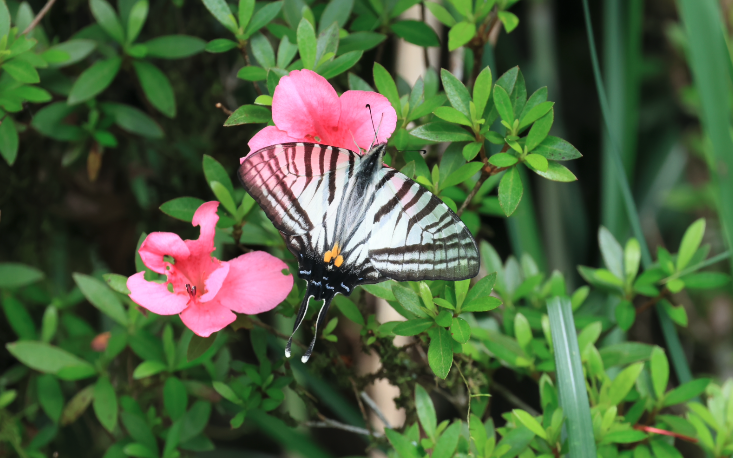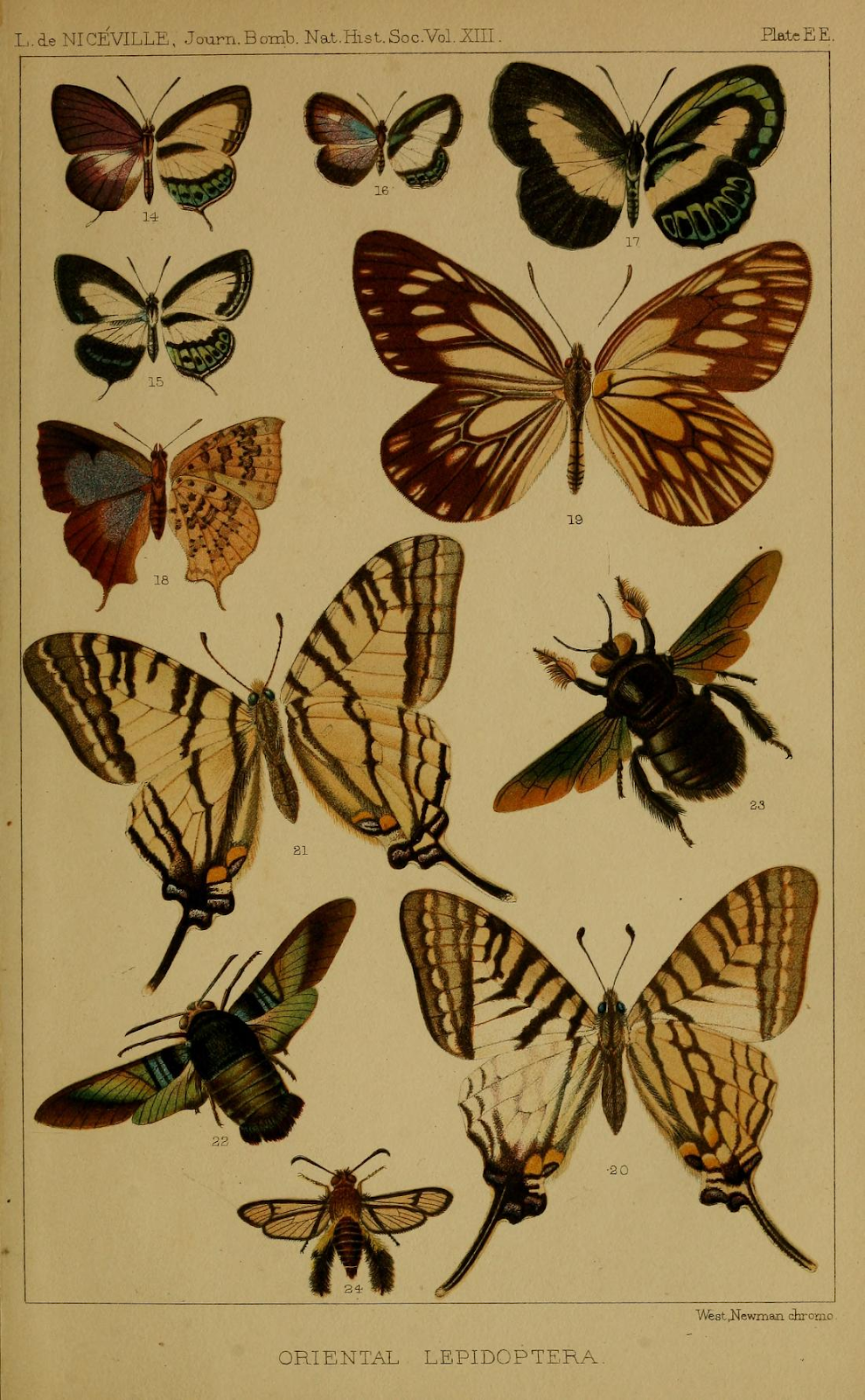Graphium eurous, the Six-Barred Swordtail, has an English name that makes logical sense: Each hind wing has a long tail shaped like a sword, and each forewing has six black bars on a white background inside the black-and-white band on the border. The name is often written "Sixbar Swordtail," and some older sources call this species the "Great Jay." Though not very big by south Asian standards, with a wingspan of 5-6 cm, it's bigger than some other Graphiums.
The white color can iridesce pale yellow, rather than pale blue, to match the amber-yellow spots.
The wings can be very transparent; you can see the twig through the wing of the butterfly shown above, and you can see the pink flower through the wing of the one shown below.
The Graphium species were once lumped into the genus Papilio; some now want to split this and some similar-looking Swordtails into a new genus name, Pazala. The species eurous has been classified together with some other species that look similar. The other Graphium species thought to be closely related to eurous, and sometimes classified in the genus or subgenus Pazala, are alebion, glycerion, hoenei, incerta, mandarinus, mullah, tamerlanus, and timur. Additional species names have been proposed by people trying to identify a consistent rule for identifying glycerion and mandarinus.
The only meaning for eurous Google shows is an occasional article about international activities with "Euro-US" divisions. Euros or Eurus was a name given to the east or southeast wind. Forms like eurous, euri, euroi, euron, etc., are produced by the grammar of some languages. Proposed subspecies names usually refer to places, except for panopaea, a minor heroine in the Aeneid. With a name literally meaning "all eyes/face/view," Panope or Panopaea might once have been a name for a sea goddess some group actually worshipped in some part of prehistoric Greece. By the time Greeks began writing their own history, however, the name was used by humans. When the sea was identified with Poseidon or Tethys, Panope was not mentioned. When it was identified with Nereus and Doris, Panope was listed as one of their up to fifty daughters. In poems including the Aeneid, none of these sisters was ever married; they lived with their parents, and seven of them were specifically mentioned as having helped Aeneas in the form of favorable winds and currents. Probably these "daughters of the sea" always were fanciful names given to winds and currents found at different places.
Some sources identify different subspecies of eurous; little overlap among lists of subspecies is found. One subspecies or another is found in much of southeastern Asia from the Himalayas to Taiwan. Proposed subspecies names include, though they're probably not limited to, asakurae, caschmirensis, eurous, formosanus, inthanon, koxinga, melli, meridionalis, panopaea, and sikkimica. Most online sources don't mention subspecies. INaturalist has a page for Graphium eurous generally, which includes some photos identified as Graphium eurous asakurae, and a page for G.e. asakurae; the photos are the same.
Photo by Modrawnu1984, showing several of the subspecies asakurae puddling together with a few other butterflies of different species in China. G.e. asakurae is the subspecies found in Taiwan.
Graphium eurous eurous is found in Assam, Bhutan, Manipur, Nepal, Sikkim, and Yunnan.
Photo by Rattanapong Jennarongsak, showing the subspecies inthanon in Chiang Mai, Thailand. G.e. inthanon is found in Thailand and Laos.
G.e. meridionalis is found in China. Indiabiodiversity.org lists inthanon and meridionalis as synonyms of eurous, denying that consistent differences exist. The Japanese site Yutaka lumps inthanon and sikkimica together as essentially the same:
A subspecies G.e. melli, added to some lists in 2009, is found in southern China.
G.e. panopaea is found in western China. It was first documented as a separate species because its hind wings have a larger unstriped white patch on the upper side.
Plate from the Journal of the Bombay Natural History Society, digitally photographed by Funet.fi. G.e. panopaea is the one in the lower right-hand corner. The underside of each butterfly's wings is drawn on the right side of each species. The one on the left edge of the page was listed in this journal as a distinct species, Graphium parus, described as most like Graphium tamerlanus but consistently different from it in small ways. G. tamerlanus (or Pazala tamerlana) is still listed as a distinct species today.
G.e. sikkimica is found in Sikkim. It is not always distinguished from G.e. eurous, also listed as living in Sikkim. Wikipedia has a separate photo file for the subspecies sikkimica but not a separate article/
These butterflies are not toxic enough to scare off predators; they are often photographed with not only the tails bitten off, but chunks being bitten out of their wings.
They are pollinators, often photographed sipping nectar from white or pink flowers including Prunus species. They also drink water. Male Swallowtails usually sip salty or bitter water with high concentration of mineral salts, which they need in order to reproduce. Females usually drink only relatively pure water; they get their mineral salts from the male, Graphium euros is known to get mineral salts from puddles of animal urine. Like other butterflies that crave mineral salts, it can be persuaded to sit on humans' hands, licking sweat, if humans really want to let it do this. Probably individual butterflies who congregate at such puddles are male, but male and female eurous look alike.
For a relatively common and widespread species, Graphium eurous has had remarkably little documentation of its early life. It has one generation each year; most adults fly between March and May, earlier in locations further east. In Assam its active season may begin in January.
Caterpillars have been found on leaves in the Annonaceae family, on two species in the genus Machilus. Pictureinsect.com, which is not a reliable source, says they have also been found on species of Aristolochia. A paper documenting the early stages of, cautiously, only G.e. caschmirensis has been published; it acknowledges that entomologists have yet to establish whether caschmirensis is a subspecies of Graphium eurous, of G. glycerion, or of G. mandarinus. How entomologists can say which of these butterflies are species, and which are subspecies, without having studied how the animals breed, is indeed a mystery.
The caschmirensis caterpillars, whatever they may turn out to be, were found by Peter Smetacek eating leaves of Persea duthei and Neolitsea umbrosa and reared to adulthood on those food plants. They are green, peppered with tiny black dots, well camouflaged against leaves. They did not use their osmeteria in defensive displays, but tended to freeze when startled, trying to maintain camouflage. Smetacek found only one caterpillar on each Neolitsea bush. The caterpillars are almost as "spindle-shaped" as the pupae. The adults had white patches on the fore wings, and very faint black stripes on the upper hind wings but clear black stripes with one yellow stripe on the underside.
Smetacek also mentions that these butterflies had, actually, been extensively studied in India, but that studies attempting to clarify which types are subspecies and which are species had not been conclusive enough to be reliable or to be more widely published. He lists twenty printed papers for reference.
In fact some entomologists now seem to want to discard the whole traditional set of names for what Funet calls "the eurous species group" and begin again. In response to the question whether a butterfly found in Vietnam would be eurous or mandarinus, in 2018 an entomologist stated at an online forum that it would be either confucianus or daiyuanensis--names Professors Leech, Rothschild, and Oberthur never heard. These species, though very pretty, are not especially important economically--if they are symbiotic with Annonaceae, they're not symbiotic with any of the Annonaceae that produce humans' favorite fruits--so finding out exactly what they eat and whether they really are distinct species is unlikely to be a top priority for countries like China and India. It might still make some entomologist famous, if not rich.
The page links to a paper reclassifying Graphium mandarinus into new species that have not yet, in seven years, displaced the traditional species names. According to the authors, eurous and mullah form an "out-group" whose species names may remain the same.








No comments:
Post a Comment